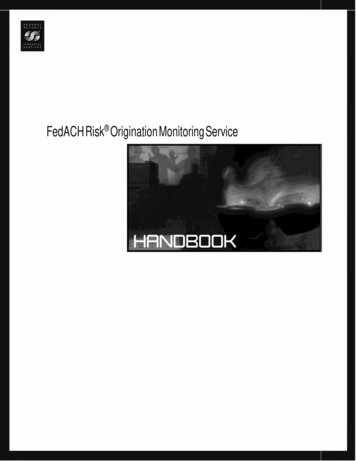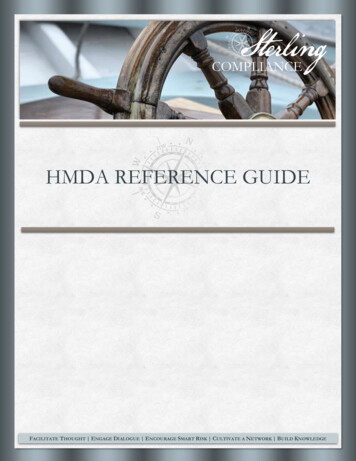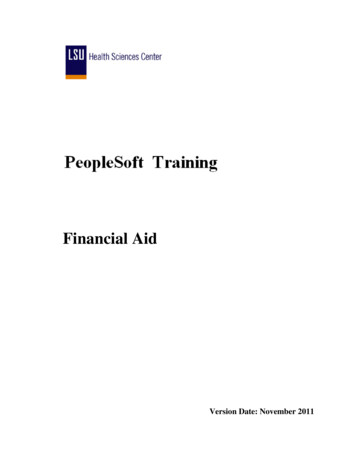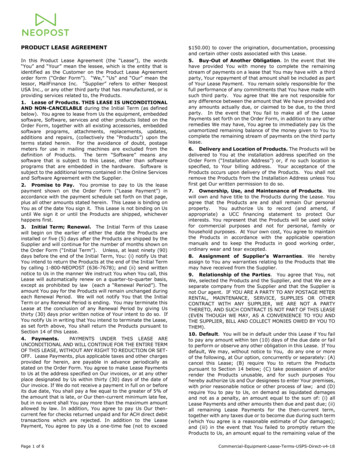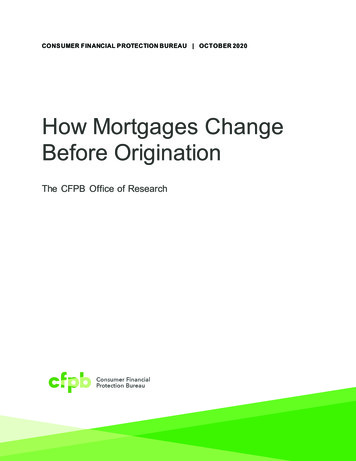
Transcription
CONS UMER FINANCIAL P ROTECTION BUREAU OCTOBER 2020How Mortgages ChangeBefore OriginationThe CFPB Office of Research
This is another in an occasional series of publications from the Consumer Financial ProtectionBureau’s Office of Research. These publications are intended to further the Bureau’s objective ofproviding an evidence-based perspective on consumer financial markets, consumer behavior,and regulations to inform the public discourse. See 12 U.S.C. §5493(b).111T h is r eport was prepared by Du stin Beckett, Br ian Bu cks, Nicholas Li, and Ev a Nagypal.CONSUMER FINANCIAL PROTECTION BUREAU
Table of contentsTable of contents .21.Introduction .32.Background and data .62.1The TRID Rule . 62.2Data . 83.Timing of disclosure forms in mortgage origination .114.Disclosure form counts .165.Changes in mortgage terms.206.Mortgage changes after consummation .277.Conclusion.312CONSUMER FINANCIAL PROTECTION BUREAU
1. IntroductionThe terms and costs of mortgage loans (mortgages) can change during the origination process.This fact has long been recognized. For instance, Federal disclosure laws evolved to requiredisclosure forms be provided to consumers both when they apply for mortgages and before theyconsummate their mortgages. However, little is known about the nature of changes during themortgage origination process. How mortgages change, by how much, and when are allimportant because consumers rely on disclosure forms to comparison shop among lenders andservice providers, and to understand the terms and costs of their mortgages. Significantchanges in mortgage terms or costs from those that are initially disclosed can make it difficultfor consumers to make informed mortgage choices.This Data Point provides new information about the types of changes that occur during themortgage origination process, their size and prevalence, and when they (and other mortgagemilestones) occur in the mortgage origination process. This information is taken from a datasetof disclosure forms from roughly 50,000 mortgages originated between March 2016 andNovember 2017. Because lenders are required to provide new disclosure forms to consumerswhen mortgages change in certain ways, this analysis provides a window into how mortgageschange and when these changes are disclosed to consumers. 2This Data Point is being released at the same time as a Bureau report assessing the “IntegratedMortgage Disclosures Under the Real Estate Settlement Procedures Act (Regulation X) and theTruth in Lending Act (Regulation Z)” Rule (TRID Rule). The TRID Rule updated how Federallaws governing mortgage disclosure forms were implemented, including by combiningpreviously separate and overlapping disclosure forms. The primary data source used in thisData Point contains mortgages originated after the TRID Rule took effect and so cannot speakto how the TRID Rule may have changed the size, prevalence, and timing of changes inmortgage terms. However, when possible, this Data Point reports data from other sources thatallow for comparisons before and after the TRID Rule took effect. These data include responsesto mortgage industry surveys fielded as part of the Bureau’s assessment of the TRID Rule. 32Len ders m ay also g ive the consumer a revised disclosure form ev en when it is not required by law, out of courtesy orcu stom . Disclosure form provision is discussed further in Section 2: Background and data. See Bureau of Con sumerFin . Prot., Integrated Mortgage Dis closures Under the Real Es tate Settlement Procedures Act (Regulation X) andthe Truth in Lending Act (Regulation Z) Rule Assessment (Oct. 1 , 2020), https://www.consumerfinance.gov /datar esearch/research-reports/trid-rule-assessm ent.33Id.CONSUMER FINANCIAL PROTECTION BUREAU
Key findings include: Almost 90 percent of mortgages received at least one revision (either a revised LoanEstimate or a corrected Closing Disclosure). About 62 percent received at least one revisedLoan Estimate, and about 49 percent received at least one corrected Closing Disclosure. The prevalence of changes in loan terms between the first Loan Estimate and the last ClosingDisclosure varied greatly across mortgage terms tracked in Bureau data. For example, theannual percentage rate (APR) 4 changed for more than 40 percent of mortgages, the loanamount and the loan-to-value (LTV) 5 ratio changed for almost a quarter of mortgages, andthe interest rate changed for about eight percent. In contrast, changes to maturity, loan type(conventional, Veterans Affairs (VA), Federal Housing Administration (FHA), United StatesDepartment of Agriculture (USDA), 6 rate type (fixed or adjustable-rate), and loan purpose(purchase, refinance, etc.) were relatively rare. Similarly, the magnitude of changes varied widely among the mortgage terms tracked in theBureau data. Changes to loan amount and APR were relatively small, whereas manychanges to interest rate and LTV ratio were relatively large. The disparity between themagnitude of changes in APR and interest rate are at least partly mechanical—APR wouldlikely change slightly in response to small changes in loan amount or closing costs. According to survey data, the disparities between the prevalence and magnitudes of changesto APR and changes to interest rate may also be due to precautions lenders took to avoidtolerance violations. More than three-quarters of respondents said their institution“sometimes,” “often,” or “almost always” estimated fees at the top of their range to avoidpossible tolerance violations. The use of this strategy would imply that mortgage costs onthe Closing Disclosure would often be lower than initial estimates, and these changes wouldsubsequently show up in the Bureau’s data as a small decrease in APR. The median number of days between application and consumers receiving their first LoanEstimate was one calendar day. Thus, for most mortgages, lenders provided Loan Estimatessooner than they were required to under the TRID Rule.4A n APR is a broader m easure of t he cost of borrowing money than the interest rate. T he A PR r eflects t he interestr a te, any points, m ortgage brok er fees, and other charges that the borrower pays t o get the loan. For that r eason, theA PR is u sually h igher than the interest rate on a m ortgage. See Bureau of Consumer Fin. Prot., What is the differencebetw een a m ortgage interest rate and an APR? (Updated Nov . 1 5, 2019), https://www.consumerfinance.gov /askcfpb/what-is-the-difference-between-a-m ortgage-interest-rate-and-an-apr-en-1 35/.5T h e LTV ratio is a m easure com paring t he amount of a borrower’s m ortgage with the a ppraised value of t hepr operty. T he h igher the borrower’s down payment, t he lower the LTV ratio.6A conventional m ortgage or conventional loan is a hom e buyer’s loan t hat is not offered or secured by a gov ernmenten t ity. It is available through or guaranteed by a private lender or the two gov ernment-sponsored enterprises—Fa n nie Ma e and Freddie Ma c. A VA loan is a mortgage offered t hrough a Department of V eterans Affairs program. AFHA loan is a m ortgage that is insured by t he Federal Housing Adm inistration (FHA) and issued by an FHA-approv edlen der. A USDA loan is a m ortgage guaranteed or issued by t he USA or a pprov ed lender t o rural and suburbanbor r owers.4CONSUMER FINANCIAL PROTECTION BUREAU
The median number of days between consumers receiving their first Closing Disclosure andclosing on their mortgage was six calendar days. Thus, for most mortgages, lendersprovided Closing Disclosures sooner than they were required to under the TRID Rule. The time between applying for and closing on a mortgage varied significantly. The mediannumber of days between application and closing was 44 calendar days, and for half ofmortgages, this duration was between 35 and 57 days (the 25 th and 75 th percentiles). Almost half of the mortgages had at least one post-closing Closing Disclosure, which is acorrected Closing Disclosure that is generated after a mortgage is consummated. Thefinance charge and APR changed between the last Closing Disclosure and the last postclosing Closing Disclosure for only about one percent of mortgages with a post-closingClosing Disclosure, and changes to other loan terms were even rarer. This underscores thefact that many post-closing Closing Disclosures are generated in response to secondarymarket requirements and do not necessarily reflect substantial changes to the mortgage.This Data Point is organized as follows. Section 2 provides background. Section 2.1 describesrelevant provisions of the TRID Rule, including when disclosures must be provided and thedetails around when terms and costs are allowed to change. Section 2.2 describes the dataanalyzed in this Data Point. Sections 3 through 5 report on disclosure form timing, disclosureform counts, and the prevalence and magnitude of changes in certain mortgage terms,respectively. Finally, Section 6 describes data on Closing Disclosures provided after closing andSection 7 provides this Data Point’s conclusion.5CONSUMER FINANCIAL PROTECTION BUREAU
2. Background and data2.1The TRID RuleIn November 2013, the Bureau issued a final rule titled “Integrated Mortgage Disclosures Underthe Real Estate Settlement Procedures Act (Regulation X) and the Truth in Lending Act(Regulation Z)” 7 to implement sections 1098 and 1100A of the Dodd-Frank Wall Street Reformand Consumer Protection Act (Dodd-Frank Act) as well as certain other new provisions enactedin the Dodd-Frank Act. 8 The Bureau amended the 2013 final rule on two occasions before itseffective date, and the amended rule took effect on October 3, 2015.9 This Data Point refers tothe rule as amended when it took effect on October 3, 2015, as the “TRID Rule”. The Bureausubsequently amended the TRID Rule in July 2017 and April 2018. 10 The July 2017Amendments took effect on October 10, 2017,1 1 and the April 2018 Amendments took effect onJune 1, 2018. 1 2Before the TRID Rule, Federal law generally required that consumers applying for mortgages gettwo different forms: one with disclosures regarding the cost of credit and another concerningreal estate settlement costs. Shortly before closing on the loan, consumers received twoadditional forms; again, one regarding the cost of credit and another concerning real estatesettlement costs. These disclosure forms were required by two distinct federal statutes, theTruth in Lending Act (TILA) and the Real Estate Settlement Procedures Act (RESPA). Prior tothe Bureau’s creation, two federal agencies, the Board of Governors of the Federal ReserveSystem (Board) and the U.S. Department of Housing and Urban Development (HUD),developed and oversaw these disclosures.77 8 Fed. Reg. 7 9730. (Dec. 31, 2013).8 T h e contents of this subsection are largely transcribed fromt he T RID Rule assessment r eport. For morein formation about the T RID Ru le, see Bureau of Con sumer Fin. Prot., Integrated Mortgage Dis closures Under theReal Es tate Settlement Procedures Act (Regulation X) and the Truth in Lending Act (Regulation Z) Rule Assessment(Oct . 1, 2020), https://www.consumerfinance.gov /data-research/research-reports/trid-rule-assessm ent.9See 8 0 Fed. Reg. 8767 (Feb. 19, 2015); 80 Fed. Reg. 43911 (July 24, 2015).10See 82 Fed. Reg. 37656 (Aug. 1 1, 2017); 83 Fed. Reg. 19159 (May 2, 2018).11Id. T h e July 2017 Amendm ents were effective Oct. 1 0, 2017, but the July 2017 Am endments had an optionalcom pliance period in effect until Oct. 1, 2018. 82 Fed. Reg. 37656, 37762-65. (Aug. 1 1, 2017).1268 3 Fed. Reg. 19159. (May 2, 2018).CONSUMER FINANCIAL PROTECTION BUREAU
The TRID Rule combined these two sets of forms into a single set of forms. The TRID Rulegenerally requires that both a Loan Estimate and Closing Disclosure be provided for closed-endconsumer credit transactions secured by real property or a cooperative unit. 1 3 Home EquityLines of Credit are not subject to the TRID Rule, nor are chattel-dwelling loans. In addition, theTRID Rule specifically exempts reverse mortgages.The TRID Rule requires the creditor or mortgage broker to give the Loan Estimate to theconsumer within three business days after the consumer applies for a mortgage. 1 4 The TRIDRule defines an “application” for these purposes, namely, the consumer’s name, income, socialsecurity number to obtain a credit report, the property address, an estimate of the value of theproperty, and the mortgage amount sought. 1 5The TRID Rule generally requires that the creditor ensure the consumer receives the ClosingDisclosure no later than three business days before consummation.1 6 To prevent closing delays,the TRID Rule allows creditors to update Closing Disclosures in certain circumstances withouttriggering an additional three-business-day waiting period. 1 7 A corrected Closing Disclosuremust be issued with a new three-business-day review period if, between the time the ClosingDisclosure is first provided and consummation, the loan’s APR becomes inaccurate (beyond thespecified tolerance level), the loan product changes, or a prepayment penalty is added. 1 8 Allother changes to the Closing Disclosure may be made without an additional three-business-dayreview period, but a corrected Closing Disclosure must be provided at or before loan closing. 1 9131 2 C.F.R. § 1 026.19(e)(1)(i) and (f)(1)(i).14See 1 2 C.F.R. § 1 026.19(e)(1)(iii).15See 1 2 C.F.R. § 1 026.2(a)(3). Consistent with prior r equirements, the creditor generally cannot im pose any fees ona con sumer in connection with a consumer’s application (other than a fee for obtaining t he consumer’s credit report)u n til after t he consumer has received the Loan Est imate and the consumer has indicated an intent t o proceed with thet r ansaction. See C.F.R. § 1 026.19(e)(2)(i).16See 1 2 C.F.R. § 1 026.19(f)(1)(ii). T ILA, a s im plem ented by Regulation Z, g enerally prov ides that, if the early T ILAdisclosures (TIL) contain an APR that becom es inaccurate, the creditor shall furnish corrected T ILA disclosures sot h at they are received by the consumer not later t han three business days before consummation. On the other hand,RESPA a nd Regulation X g enerally r equire that the RESPA settlem ent statement be prov ided t o the borrower a t orbefor e settlement.17See 1 2 C.F.R. § 1 026.19(f)(2)(i).18 1 2C.F.R. § 1 026.19(f)(2)(ii).191 2 C.F.R. § 1 026.19(f)(2). Closing and consummation are separate ev ents but generally occur around the sam et im e. “ Consummation” is when t he consumer becom es contractually obligated t o the creditor on the loan. T hedefinition of “closing” varies by state, but roughly speaking, is the process through which deeds are conveyed,r ecorded, and transacted (when applicable), funds are exchanged (or placed in the settlement agent’s possession), and7CONSUMER FINANCIAL PROTECTION BUREAU
The TRID Rule also changed the tolerance rules that limit creditors and third-party serviceproviders from charging consumers settlement costs that exceed the estimates that had beenpreviously disclosed. Prior to the TRID Rule, HUD amended Regulation X in 2008 to requiredisclosing estimated settlement costs on the Good Faith Estimate (GFE) form and establishedtolerances for such amounts. 20 The GFE tolerance rules generally place charges into threecategories: (1) the creditor’s charges for its own services, which cannot exceed the creditor'sestimates unless an exception applies (zero tolerance); (2) charges for settlement servicesprovided by third parties, which cannot exceed estimated amounts by more than ten percentunless an exception applies (ten percent tolerance); and (3) other charges that are not subject toany limitation on increases (no tolerance limit). 21The TRID Rule subjects a larger category of charges to a zero tolerance prohibition on costincreases than was the case previously under RESPA. Specifically, the TRID Rule expands thezero tolerance category to also include fees charged by affiliates of creditors, fees charged byservice providers selected by the creditor, and fees for services for which the creditor does notpermit consumers to shop. However, if there is a valid justification for the cost increase, such asif the consumer asks for a change, the consumer chooses a service provider that was notidentified by the creditor, or the information provided at application was inaccurate or becomesinaccurate, the creditor can reset the tolerance limits by providing a revised Loan Estimate or aClosing Disclosure with the updated costs within three business days. 22 Additionally, the TRIDRule retains Regulation X’s provisions which allow creditors to cure tolerance violations throughproviding a refund to the consumer, of the amount by which the tolerance was exceeded, at orwithin 30 days of closing. 232.2DataAnalyses in this Data Point rely primarily on de-identified mortgage disclosure form dataobtained through the Bureau’s supervisory activities. When possible and relevant, to providesome insight into how practices may now differ from before the TRID Rule, the discussiont h e legal obligations of the parties (buyer/consumer, seller (if applicable), r eal estate agent, creditor, lienholders, andt h ird-party service prov iders) are resolved.207 3 Fed. Reg. 68203 (Nov. 17, 2008). See also 1 2 C.F.R. § 1 024.7. T his Regulation X prov ision continues t o applyw ith respect to certain mortgages not subject to the TRID Ru le.211 2 C.F.R. § 1 024.7(e).22See 1 2 C.F.R. § 1 026.19(e)(3) and (4).23W h ereas Regulation X allows creditors t o cure t olerance violations by prov iding the refund 30 days a fterset t lem ent, for tolerance v iolations under the TRID Ru le the cure period was lengthened t o 60 days a ftercon summation. 12 C.F.R. § 1 024.7(i); 1 2 C.F.R. § 1 026.19(f)(2)(v).8CONSUMER FINANCIAL PROTECTION BUREAU
draws on data from the Bureau’s assessment of the TRID Rule and summary statistics bothbefore and after the TRID Rule provided to the Bureau by a provider of loan origination systems.2.2.1 CFPB Compliance Tool DataThe Bureau’s examiners used software (Compliance Tool) to collect data directly fromsupervised entities. The Compliance Tool processed a sample of loan files during an exam tocheck for compliance, keeping certain selected data fields for analysis. The Compliance Toolassisted examiners as they checked for compliance with TILA, RESPA, and the TRID Rule,among other statutes and regulations. The information the tool collected includes borrower andloan characteristics and information about disclosures provided to borrowers.This Data Point analyzes a sample of exam data collected by the Compliance Tool. The sampleincludes data from mortgage disclosure forms for over 50,000 mortgages consummatedbetween March 2016 and November 2017.The analysis of these data comes with several caveats. First, the data were only collected formortgages originated after the TRID Rule took effect and therefore they cannot be used to inferthe effects of the TRID Rule. Second, the included mortgages were selected based on dataquality and completeness considerations—these data therefore are not representative of allmortgages or even of all mortgages examined by the Bureau. 242.2.2 Industry Survey DataIn January 2020, the Bureau conducted three surveys of mortgage industry participants: asurvey of mortgage lenders, a survey of mortgage loan officers, and a survey of companies thatconduct real-estate closings. These surveys were created to supplement the Bureau’sassessment of the effectiveness of the TRID Rule by collecting data and information on theexperiences of industry participants before, during, and after the TRID Rule’s effective date. 25Eligible individuals were generally those in their role in the mortgage market both at the time ofthe survey and before the TRID Rule took effect.24For ex ample, due to divergent information technology solutions em ploy ed, different examined entities prov idedm or e or less com plete set of disclosures for m ortgages they originated, and this influenced whether their data werein cluded in the current analysis.25Bu r eau of Consumer Fin. Prot., Integrated Mortgage Disclosures Under the Real Estate Settlement Procedures Act(Reg ulation X) and the Truth in Lending Act (Regulation Z) Rule Assessm ent (Oct. 1 , 2020),h t tps://www.consumerfinance.gov /data-research/research-reports/trid-rule-assessm ent.9CONSUMER FINANCIAL PROTECTION BUREAU
The surveys were distributed online between January 22, 2020 and March 13, 2020. TheBureau received over 1,000 responses across all three surveys. Survey data reported hereinclude only responses from respondents who completed at least 65 percent of the questions intheir survey.26The survey data have two potential limitations, however. First, the data were collected in 2020,and so estimates of practices or behaviors prior to the TRID Rule’s effective date likely relied onrespondents’ recollection of facts at least four and a half years in the past. These data maytherefore be inaccurate due to recall errors. Second, responses are not likely to berepresentative of all lenders, loan officers, or closing companies because the surveys werevoluntary.2.2.3 Summary statistics from a mortgage service providerA mortgage service provider voluntarily provided the Bureau data generated by its loanorigination system. These data include summary statistics of mortgages originated between2013 and 2019 on the number of disclosure forms generated per mortgage both before and afterthe TRID Rule’s effective date.26For m ore information a bout t he T RID a ssessm ent industry surveys, see Bureau of Consumer Fin. Prot., In tegratedMor t gage Disclosures Under the Real Est ate Settlement Procedures Act (Regulation X ) and t he Truth in Lending Act(Reg ulation Z) Rule Assessm ent, Appendix D (Oct. 1 , 2020), https://www.consumerfinance.gov/datar esearch/research-reports/trid-rule-assessm ent.10CONSUMER FINANCIAL PROTECTION BUREAU
3. Timing of disclosure forms inmortgage originationThe process of getting a mortgage may involve several steps including shopping for and takingout a mortgage, shopping for settlement services, and purchasing a home (unless the borroweris refinancing). The sooner disclosure forms are provided to consumers, the sooner they canunderstand the terms and costs of their mortgage offer, negotiate these terms or costs, or use thedisclosures to shop for other offers or settlement services. This section first describes the timingof TRID disclosure forms in the Compliance Tool data and breaks down the timing of differentstages in the process. It then presents data from the TRID Assessment survey of Loan Officers(Loan Officer Survey) and the TRID Assessment survey of Closing Companies (Closing CompanySurvey) to compare timing before and after the TRID Rule took effect.TABL E 1:VARIOUS PERCENTILES OF NUMBER OF DAYS BETWEEN MILESTONES AND DELIVERY OFDISCLOSURE FORMSApp toFirst LEApp toClosingFirst LEtoLast LE*First LEtoLast CDFirst CDtoLast CD*First CDtoClosingLast 6375th357365288590th575557014138Percentile* Da t a presented in column “ First LE t o La st LE” exclude mortgages that received only on e Loan Est imate (37.9per cent of all mortgages), and data presented in column “ First CD t o Last CD” exclude m ortgages that received onlyon e Closing Disclosure (5 1.2 percent of a ll mortgages).11CONSUMER FINANCIAL PROTECTION BUREAU
Table 1 displays percentiles of the number of calendar days in the Compliance Tool data betweenvarious milestones in the origination process. 27 The milestones include the issuance of the firstand last Loan Estimates (LE), the issuance of the first and last Closing Disclosures (CD), theloan application date (App), and the loan consummation date (Closing). The median number ofdays between the first Loan Estimate and the last Closing Disclosure was 38 days, and themedian duration between application and closing was 44 days. Half of mortgages went fromapplication to closing in about one or two months (the interquartile range was 35 to 57 days);ten percent of mortgages took more than about 2.5 months (the 90 th percentile was 75 days).The mortgage origination process moved reasonably quickly for the median borrower at eachstage. However, there was also great variability in many stages. The process for mortgages thatrequire multiple Loan Estimates can be particularly protracted; roughly a quarter received LoanEstimates over the course of more than a month (the upper quartile was 36 days). The stages ofClosing Disclosure provision moved relatively quickly with closing usually coming within a weekof the first Closing Disclosure.TABL E 2:PERCENTAGE DISTRIBUTION OF AVERAGE NUMBER OF DAYS BETWEEN THE PROVISION OFTHE FIRST HUD-1 AND CLOSINGAverage number of daysShare (percent)Zero business days20.0One business day before43.5Two business days before20.9Three or more business days before11.3Did not respond4.4Sample size11527T h e table displays calendar days rather than business days. The TRID Ru le’s t iming requirem ents are generallyspecified in terms of business days. This analysis uses calendar days, as opposed to business days, t o measuredifferences between dates of v arious events since a non-negligible number of ev ents fall on weekends and holidays.A lso, calendar days m ay constitute the natural unit of t ime for consumers.12CONSUMER FINANCIAL PROTECTION BUREAU
Table 2 displays responses to a question from the Closing Company Survey that askedrespondents to recall, how many days before closing they gave borrowers the first HUD-1settlement statement (HUD-1), in the 12 months before the TRID Rule. 28 About 20 percentresponded that they provided the HUD-1 on the same day as closing, on average, while onlyabout 11 percent responded that they provided the HUD-1 three or more business days beforeclosing. In contrast, after the TRID Rule took effect, all lenders were required to provide thefirst Closing Disclosure at least three business days before consummation.29TABL E 3:PERCENTAGE DISTRIBUTION OF AVERAGE NUMBER OF DAYS BETWEEN PROVISION OF THELAST CLOSING DISCLOSURE AND CONSUMMATIONAverage number of daysShare (percent)Zero business days12.0One business day before22.8Two business days before13.6Three or more business days before36.4I don’t know8.7Did not respond6.5Sample size18428 See Bu reau of Consumer Fin. Pr ot., Integrated Mor tgage Disclosures Under the RealEstate Settlement ProceduresA ct (Regulation X) and the Truth in Lending A ct (Regulation Z) Rule A ssessment, A ppendix D, T RID A ssessm entSu rvey of Closing Com panies, qu estion 1 2 (Oct. 1 , 2020), archr eports/trid-rule-assessm ent.297 8 Fed. Reg. 7 9730, 80086. (Dec. 31, 2013). T ILA, a s im plemented by Regulation Z, g enerally prov ides that, if t heea r ly T ruth in Lending (TIL) disclosures contain an A PR t hat becom es inaccurate, the creditor shall furnish correctedT IL disclosures so t hat t hey are received by the consumer not later than three business days before consummation.On t he other hand, RESPA and Regulation X generally require that the RESPA settlement statem ent be provided t ot h e borrower at or before settlem ent. T o prevent unnecessary closing delays, the initial Closing Disclosure m ayin clude estimates based on t he best information reasonably available t o the creditor. Various changes t o the ClosingDisclosure are permitted without an additional t hree-business-day waiting period. If, between the time the ClosingDisclosure is first prov ided and consummation, the loan's A PR becom es inaccurate (over and above the specifiedt olerance level), the loan product changes, or a prepayment penalty is a dded, a corrected Closing Disclosure m ust beissu ed with an a dditional three-business-day period t o review the transaction. A ll other changes t o the ClosingDisclosure m ay be made without an additional t hree-business-day waiting period, but a corrected Closing Disclosurem ust be prov ided at or before consummation.13CONSUMER FINANCIAL PROTECTION BUREAU
Table 3 displays responses to a question from the Loan Officer Survey that asked respondentshow many days before consummation they gave borrowers a Closing Disclosure that reflectedthe mortgage’s final terms and costs in 2018. 30 About 12 percent of respondents reported givingconsumers this disclosure on the same day as consummation, and slightly more than a thirdindicated they provided the final Closing Disclosure three or more business days in advance.TABL E 4:PERCENTAGE DISTRIBUTION OF AVERAGE NUMBER OF DAYS BETWEEN FIRST CONTACTAND PROVISION OF INITIAL DISCLOSUREFirst Good FaithEstimateFirst LoanEstimate3.32.2One day21.720.7Two days27.226.13 – 4 days22.325.55 – 10 days12.013.0Greater than 10 days7.66.0Did not respond6.06.5Sample size184184Average number of daysLess than one dayThe TRID Rule changed the definition of a mortgage “application” to remove the ‘‘catch-all’’element that was in the previous def
Fannie Mae and Freddie Mac . A VA loan is a mortgage offered through a Department of Veterans Affairs program. A FHA loan is a mortgage that is insured by the Federal Housing Administration (FHA) and issued by an FHA -approved lender. A USDA loan is a mortgage guarantee d or issued by the USA or approved lender to rural and suburban borrowers.

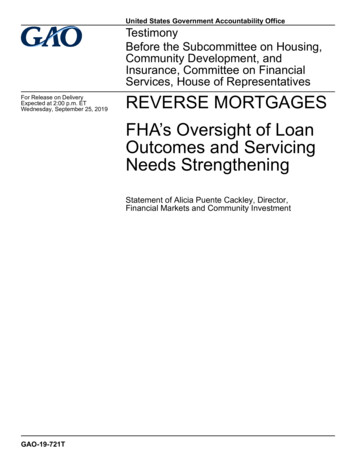
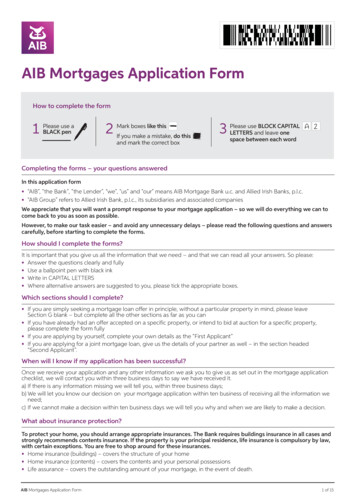
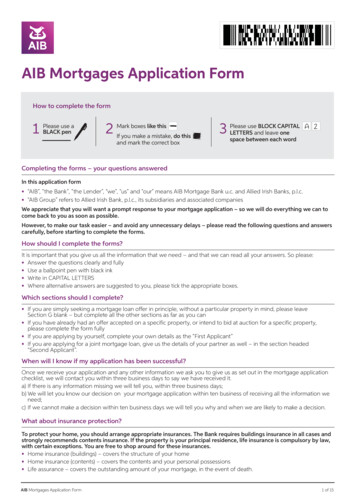
![Change Management Process For [Project Name] - West Virginia](/img/32/change-20management-20process-2003-2022-202012.jpg)

